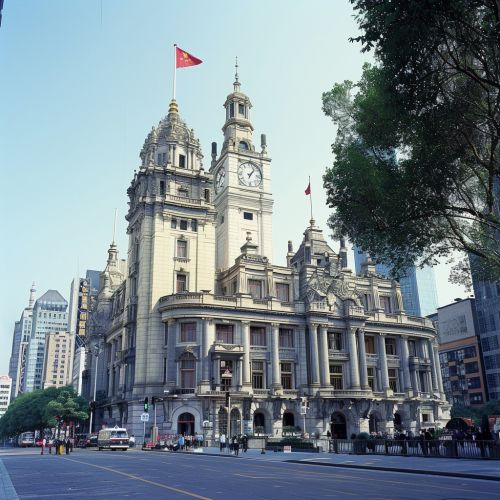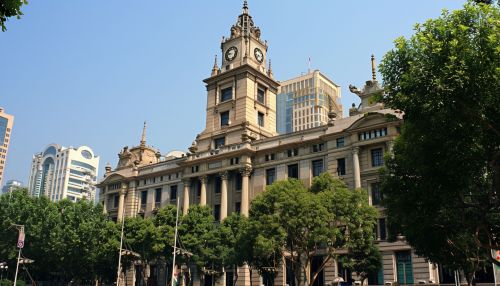The Bund: Difference between revisions
(Created page with "== Introduction == The Bund is a renowned waterfront area in central Shanghai, China. It runs along the western bank of the Huangpu River, facing the modern skyscrapers of the Lujiazui area in the Pudong district. The Bund is celebrated for its historical buildings, which once housed numerous banks and trading houses from countries such as the United Kingdom, France, the United States, Germany, Japan, the Netherlands, and Belgium. This area is a testament to Shanghai's r...") |
No edit summary |
||
| Line 13: | Line 13: | ||
Built in 1927, the Customs House is a prime example of Neoclassical architecture. It features a clock tower modeled after Big Ben in London. The building served as the central customs office for Shanghai, playing a crucial role in the city's trade activities. | Built in 1927, the Customs House is a prime example of Neoclassical architecture. It features a clock tower modeled after Big Ben in London. The building served as the central customs office for Shanghai, playing a crucial role in the city's trade activities. | ||
[[Image:Detail-92613.jpg|thumb|center|The Customs House in Shanghai, featuring a Neoclassical design with a prominent clock tower.|class=only_on_mobile]] | |||
[[Image:Detail-92614.jpg|thumb|center|The Customs House in Shanghai, featuring a Neoclassical design with a prominent clock tower.|class=only_on_desktop]] | |||
=== The HSBC Building === | === The HSBC Building === | ||
Latest revision as of 13:34, 18 June 2024
Introduction
The Bund is a renowned waterfront area in central Shanghai, China. It runs along the western bank of the Huangpu River, facing the modern skyscrapers of the Lujiazui area in the Pudong district. The Bund is celebrated for its historical buildings, which once housed numerous banks and trading houses from countries such as the United Kingdom, France, the United States, Germany, Japan, the Netherlands, and Belgium. This area is a testament to Shanghai's rich colonial history and its evolution into a global financial hub.
Historical Background
The Bund's history dates back to the mid-19th century when Shanghai was opened to foreign trade following the Treaty of Nanking in 1842. The area quickly became a focal point for international commerce and finance. The term "Bund" originates from an Anglo-Indian word meaning an embankment or levee. The Bund was initially a muddy towpath for dragging barges of rice.
By the early 20th century, the Bund had transformed into a bustling financial district, often referred to as the "Wall Street of the East." The buildings constructed during this period reflect various architectural styles, including Neoclassical, Art Deco, and Beaux-Arts. These structures housed the headquarters of major banks, trading companies, and consulates.
Architectural Significance
The Bund is home to 52 buildings of various architectural styles. Some of the most notable structures include:
The Customs House
Built in 1927, the Customs House is a prime example of Neoclassical architecture. It features a clock tower modeled after Big Ben in London. The building served as the central customs office for Shanghai, playing a crucial role in the city's trade activities.


The HSBC Building
Constructed in 1923, the HSBC Building was once the second-largest bank building in the world. It is an excellent example of Beaux-Arts architecture, characterized by its grandiose facade and intricate interior details. The building's dome is adorned with mosaics depicting the signs of the zodiac.
The Peace Hotel
Originally known as the Cathay Hotel, the Peace Hotel is an Art Deco masterpiece. Opened in 1929, it was the tallest building in Shanghai at the time. The hotel has hosted numerous celebrities and dignitaries over the years, making it a symbol of luxury and opulence.
Economic Impact
The Bund has played a pivotal role in Shanghai's economic development. During the early 20th century, it was the epicenter of the city's financial activities. The presence of foreign banks and trading houses facilitated international trade and investment, contributing to Shanghai's status as a global financial center.
In recent years, the Bund has undergone significant redevelopment to preserve its historical heritage while integrating modern amenities. The area now features luxury hotels, high-end restaurants, and retail spaces, attracting both tourists and business professionals.
Cultural Influence
The Bund is not only a financial hub but also a cultural landmark. It has been featured in numerous films, novels, and artworks, symbolizing Shanghai's blend of Eastern and Western influences. The area is a popular destination for both locals and tourists, offering scenic views of the Huangpu River and the Pudong skyline.
The Bund is also a venue for various cultural events and festivals. The annual Shanghai International Music Fireworks Festival, for instance, attracts thousands of spectators to the waterfront. Additionally, the Bund is a popular spot for wedding photography, capturing the romantic essence of Shanghai.
Modern Developments
In the 21st century, the Bund has seen a resurgence in popularity. The Shanghai municipal government has invested heavily in the area's infrastructure, enhancing its appeal as a tourist destination and business district. The Bund Financial Center, a modern architectural complex designed by Foster + Partners and Heatherwick Studio, exemplifies the area's blend of historical and contemporary elements.
The Bund also features a pedestrian promenade, offering a leisurely experience for visitors. The promenade is lined with sculptures, gardens, and viewing platforms, providing panoramic views of the Huangpu River and the futuristic skyline of Pudong.
Environmental Considerations
The redevelopment of the Bund has incorporated various environmental sustainability measures. Green spaces have been integrated into the urban landscape, and efforts have been made to reduce the area's carbon footprint. The preservation of historical buildings has also been prioritized, ensuring that the Bund's architectural heritage is maintained for future generations.
